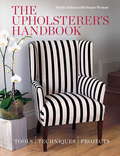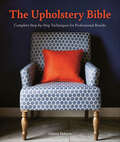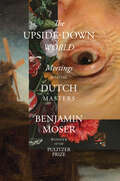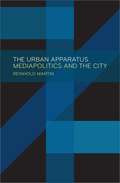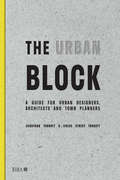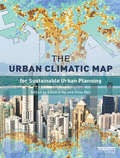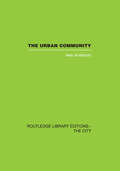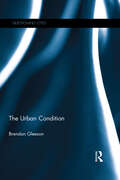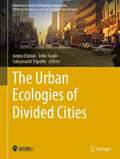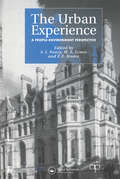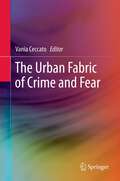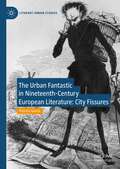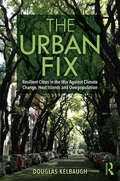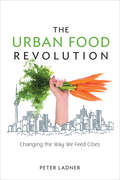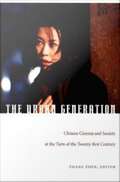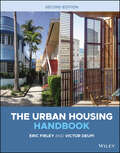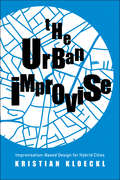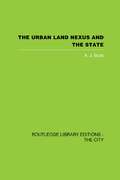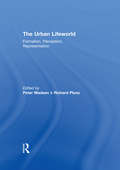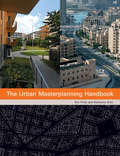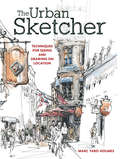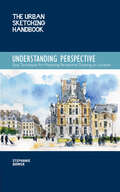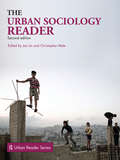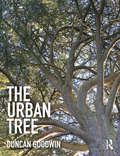- Table View
- List View
The Upholsterer's Handbook
by Nicole Fulton Stuart WestonIn eye-capturing style The Upholsterer's Handbook offers everything you need and more, in order to prepare and inspire you to create beautifully upholstered furniture. The upholstered pieces range in skill level from simple seats to more complex items such as a button-back chair. Various styles of furniture are covered, from classic and elegant to other more styled and designer pieces.The Upholsterer's Handbook opens with sections on sourcing furniture, tools and materials, and choosing fabrics - including finishes and trimmings, which are often the key to the success of a piece. With special photography throughout, basic techniques are illustrated step-by-step, from stripping back to top stuffing to making cushions. 18 stunning projects are featured with varying skill levels, covering such diverse items as a G-plan chair, a sofa, a '70s flower-shaped stool, dining chairs, and headboards. Throughout Nicole Fulton demonstrates techniques using linen, satin, velvet, leather, cowhide, and other fabrics that give the furniture a unique contemporary look.
The Upholstery Bible: Complete Step-by-Step Techniques for Professional Results
by Cherry DobsonA complete course in upholstering furniture, including tooling up, selecting stuffings and outer textiles, techniques, and cutting plans. The Upholstery Bible is a one-stop resource for furniture upholstering, regardless of your abilities, with easy-to-follow, illustrated instructions explaining all the essential upholstery techniques, from covering buttons to stripping and upholstering entire chairs. Build your skills at your own pace, with advice on the basics such as choosing materials and tools for the job and estimating yardage, as well as more complex upholstering techniques. The Upholstery Bible features invaluable advice on what to look for when buying second hand furniture, teaching you what&’s fixable and what&’s not as well as how to avoid costly mistakes by choosing the right stitches, and techniques and textiles for the job. &“Dobson breaks up the technical stuff with a more inspiring approach . . . If you&’re starting out, I&’d say this would be a brilliant resource to have . . . offers plenty of answers to the most common gotchas.&” —Vintique Upholstery
The Upside-Down World: Meetings with the Dutch Masters
by Benjamin MoserPlunged into a strange land at twenty-five, Benjamin Moser began an obsessive, decades-long study of the Dutch Masters to set his world right again. Arriving as a young writer in an ancient Dutch town, Benjamin Moser found himself visiting—casually at first, and then more and more obsessively—the country’s great museums. Inside these old buildings, he discovered the remains of the Dutch Golden Age and began to unearth the strange, inspiring, and terrifying stories of the artists who gave shape to one of the most luminous moments in the history of human creativity. Beyond the sainted Rembrandt—who harbored a startling darkness—and the mysterious Vermeer, whose true subject, it turned out, was lurking in plain sight, Moser got to know a whole galaxy of geniuses: the doomed virtuoso Carel Fabritius, the anguished wunderkind Jan Lievens, the deaf prodigy Hendrik Avercamp. And through their artwork, he got to know their country, too: from the translucent churches of Pieter Saenredam to Paulus Potter’s muddy barnyards, and from Pieter de Hooch’s cozy hearths to Jacob van Ruisdael’s tragic trees. Year after year, as he tried to make a life for himself in the Netherlands, Moser found friends among these centuries-dead artists. And he found that they, too, were struggling with the same questions that he was. Why do we make art? What even is art, anyway—and what is an artist? What does it mean to succeed as an artist, and what does it mean to fail? Is art a consolation—or a mortal danger? The Upside-Down World is an invitation to ask these questions, and to turn them on their heads: to look, and then to look again. This is Holland and its great artists as we’ve never seen them before. And it’s a sumptuously illustrated, highly personal coming-of-age-story, twenty years in the making: a revealing self-portrait by one of the most acclaimed writers of his generation.
The Urban Apparatus: Mediapolitics and the City
by Reinhold MartinUrbanization is a system of power and knowledge, and today&’s city functions through the expansive material infrastructures of the urban order. In The Urban Apparatus, Reinhold Martin analyzes urbanization and the contemporary city in aesthetic, socioeconomic, and mediapolitical terms. He argues that understanding the city as infrastructure reveals urbanization to be a way of imparting functional, aesthetic, and cognitive order to a contradictory, doubly bound neoliberal regime.Blending critical philosophy, political theory, and media theory, The Urban Apparatus explores how the aesthetics of cities and their political economies overlap. In a series of ten essays, with a detailed theoretical introduction, Martin explores questions related to urban life, drawn from a wide range of global topics—from the fiscal crisis in Detroit to speculative development in Mumbai to the landscape of Mars, from discussions of race and the environment to housing and economic inequality. Each essay proposes a particular &“mediator&” (or a material complex) that is shaped by imaginative practices, each answering the question &“What is a city, today?&” The Urban Apparatus serves as an &“urban&” bookend to the architectural questions explored by Martin in his earlier book Utopia&’s Ghost, and ultimately offers readers a way to think politically about urbanization.
The Urban Block: A Guide for Urban Designers, Architects and Town Planners
by Jonathan Tarbatt Chloe Street TarbattThe block is no more than the land and building area defined by streets. It is the nature of the interface between the two, which has a critical impact on the quality of the spaces between those buildings. The importance of the block to city life is well rehearsed, and in any case, we seldom find ourselves in the business of making cities from scratch. But we are in the business of making new houses, neighbourhoods and new local centres, and we need lots of them: 250,000 a year to be imprecise. Against the background of a burgeoning housing shortage in the UK, there are varied issues to be reconciled. The Urban Block charts the fall and rise of the perimeter block as the staple of urban form and structure from ancient times. It takes you through the process of understanding, defining, structuring and designing the block. Carefully selected urban and suburban case examples explain “do's and don'ts” of good block layout and will help you to produce better masterplans, while staying in touch with commercial realities.
The Urban Climatic Map: A Methodology for Sustainable Urban Planning
by Edward Ng Chao RenRapid urbanization, higher density and more compact cities have brought about a new science of urban climatology. An understanding of the mapping of this phenomenon is crucial for urban planners. The book brings together experts in the field of Urban Climatic Mapping to provide the state of the art understanding on how urban climatic knowledge can be made available and utilized by urban planners. The book contains the technology, methodology, and various focuses and approaches of urban climatic map making. It illustrates this understanding with examples and case studies from around the world, and it explains how urban climatic information can be analysed, interpreted and applied in urban planning. The book attempts to bridge the gap between the science of urban climatology and the practice of urban planning. It provides a useful one-stop reference for postgraduates, academics and urban climatologists wishing to better understand the needs for urban climatic knowledge in city planning; and urban planners and policy makers interested in applying the knowledge to design future sustainable cities and quality urban spaces.
The Urban Condition (Questioning Cities)
by Brendan GleesonThis book will speak to the new human epoch, the Urban Age. A majority of humanity now lives for the first time in cities. The city, the highest invention of the modern age, is now the human heartland. And yet the same process that brought us the city and its wonders, modernisation, has also thrown up challenges and threats, especially climate change, resource depletion, social division and economic insecurity. This book considers how these threats are encountered and countered in the urban age, focusing on the issue of human knowledge and self-awareness, just as Hannah Arendt’s influential The Human Condition did half a century ago. The Human Condition is now The Urban Condition. And it is this condition that will define human prospects in an age of default and risk. Gleeson expertly explores the concept through three main themes. The first is an exploration of what defines the current human condition, especially the expanding cities that are at the heart of an over-consumptive world economic order. The second exposes and reviews the reawakening of forms of knowledge (‘naturalism’) that are likely to worsen not improve our comprehension of the crisis. The new ‘science of urbanism’ in popular new literature exemplifies this dangerous trend. The third and last part of the book considers prospects for a new urban, and therefore human, dispensation, ‘The Good City’. We must first journey in our urban vessels through troubled times. But can we now start to plot the way to new shores, to a safer, more resilient city that provides for human flourishing? The Urban Condition attempts this ideal, conceiving a new urbanism based on the old idea of self-limitation. The Urban Condition is an original, timely book that reconsiders and redeploys Arendt’s famous notion of The Human Condition in an age of cities and risk. It brings together several important strands of human consideration, urbanisation, climate threat, resource depletion, economic default and critical knowledge and weaves them into a new analysis of the times. It also looks to a future that is nearly with us—of changed climate, resource scarcity and economic stress. The book journeys into these troubled times, proposing the idea of Lifeboat Cities as a way of thinking about the human journey to come
The Urban Ecologies of Divided Cities (Advances in Science, Technology & Innovation)
by John Nagle Amira Osman Sabyasachi TripathiThe book discusses how division affect the fabric of cities, and people’s sense of identity and agency, and are reflected in physical features, architecture, and urban planning. The question of divided cities represents a complex and multistranded urban Ecology—at once both social and spatial; it cannot be limited to a single science or discipline, such as social or spatial fields. This suggests integrated and cross- disciplinary understandings, as well as integrated or parallel approaches and solutions. Urban ecologies of division manifest in multiple forms. One of their most palpable expressions is conflict, with parallels around the world, and often with correlations in the spatial fabric. Violence in such contexts is often a surface expression of deeper socio-economic or ideological differences. Whether as a result of intervention by authority or by dissent between groups, a divided city inevitably becomes a place of conflict in various forms and intensity, eroding the joy of living and sense of collective belonging to the detriment of all. In effect, it erodes the collective advantage of being part of a more unified society. A city exists in collections of social structures which mutually form a society. A divided city implies divided social structures and, in consequence, a divided society. The papers compiled in this book present many case studies of divided cities, discussing the different causes of divisions and their effects on societies. Some of the causes can be linked to conflicts, wars, colonialism, or legislative political systems. In response to the serious challenges resulting from these divisions, the book aims to provide opportunities for new approaches and possibilities for new interventions and solutions, making it significant to urban planners, architects, and policymakers.
The Urban Experience: A People-Environment Perspective
by S. J. Neary M. S. Symes F. E. BrownThis book provides a representative selection of the highest quality papers submitted to the IAPS 13 conference held in Manchester in 1994. The papers are concerned with current research on the experience of living in cities and are drawn from developed, developing and under-developed countries in all parts of the world.
The Urban Fabric of Crime and Fear
by Vania CeccatoHow does the city's urban fabric relate to crime and fear, and how is that fabric affected by crime and fear? Does the urban environment affect one's decision to commit an offence? Is there a victimisation-related inequality within cities? How do crime and fear interrelate to inequality and segregation in cities of developing countries? What are the challenges to planning cities which are both safe and sustainable? This book searches for answers to these questions in the nature of the city, particularly in the social interactions that take place in urban space distinctively guided by different land uses and people's activities. In other words, the book deals with the urban fabric of crime and fear. The novelty of the book is to place safety and security issues on the urban scale by (1) showing links between urban structure, and crime and fear, (2) illustrating how different disciplines deal with urban vulnerability to (and fear of) crime (3) including concrete examples of issues and challenges found in European and North American cities, and, without being too extensive, also in cities of the Global South.
The Urban Fantastic in Nineteenth-Century European Literature: City Fissures (Literary Urban Studies)
by Patricia GarcíaThe Urban Fantastic in Nineteenth-Century European Literature explores transnational perspectives of modern city life in Europe by engaging with the fantastic tropes and metaphors used by writers of short fiction. Focusing on the literary city and literary representations of urban experience throughout the nineteenth century, the works discussed incorporate supernatural occurrences in a European city and the supernatural of these stories stems from and belongs to the city. The argument is structured around three primary themes. “Architectures”, “Encounters” and “Rhythms” make reference to three axes of city life: material space, human encounters, and movement. This thematic approach highlights cultural continuities and thus supports the use of the label of “urban fantastic” within and across the European traditions studied here.
The Urban Fix: Resilient Cities in the War Against Climate Change, Heat Islands and Overpopulation
by Douglas KelbaughCities are one of the most significant contributors to global climate change. The rapid speed at which urban centers use large amounts of resources adds to the global crisis and can lead to extreme local heat. The Urban Fix addresses how urban design, planning and policies can counter the threats of climate change, urban heat islands and overpopulation, helping cities take full advantage of their inherent advantages and new technologies to catalyze social, cultural and physical solutions to combat the epic, unprecedented challenges humanity faces. The book fills a conspicuous void in the international dialogue on climate change and heat islands by examining both the environmental benefits in developed countries and the population benefit in developing countries. Urban heat islands can be addressed in incremental, manageable steps, such as planting trees and painting roofs white, which provide a more concrete and proactive sense of progress for policymakers and practitioners. This book is invaluable to anyone searching for a better understanding of the impact of resilient cities in the monumental and urgent fight against climate change, and provides the tools to do so.
The Urban Food Revolution: Changing the Way We Feed Cities
by Peter LadnerOur reliance on industrial agriculture has resulted in a food supply riddled with hidden environmental, economic and health care costs and beset by rising food prices. With only a handful of corporations responsible for the lion's share of the food on our supermarket shelves, we are incredibly vulnerable to supply chain disruption. The Urban Food Revolution provides a recipe for community food security based on leading innovations across North America. The author draws on his political and business experience to show that we have all the necessary ingredients to ensure that local, fresh sustainable food is affordable and widely available. He describes how cities are bringing food production home by:Growing community through neighborhood gardening, cooking and composting programsRebuilding local food processing, storage and distribution systemsInvesting in farmers markets and community supported agricultureReducing obesity through local fresh food initiatives in schools, colleges and universities.Ending inner-city food desertsProducing food locally makes people healthier, alleviates poverty, creates jobs, and makes cities safer and more beautiful. The Urban Food Revolution is an essential resource for anyone who has lost confidence in the global industrial food system and wants practical advice on how to join the local food revolution.
The Urban Generation: Chinese Cinema and Society At the Turn of the Twenty-first Century
by Zhang ZhenSince the early 1990s, while mainland China's state-owned movie studios have struggled with financial and ideological constraints, an exciting alternative cinema has developed. Dubbed the "Urban Generation," this new cinema is driven by young filmmakers who emerged in the shadow of the events at Tiananmen Square in 1989. What unites diverse directors under the "Urban Generation" rubric is their creative engagement with the wrenching economic and social transformations underway in China. Urban Generation filmmakers are vanguard interpreters of the confusion and anxiety triggered by the massive urbanization of contemporary China. This collection brings together some of the most recent original research on this emerging cinema and its relationship to Chinese society. The contributors analyze the historical and social conditions that gave rise to the Urban Generation, its aesthetic innovation, and its ambivalent relationship to China's mainstream film industry and the international film market. Focusing attention on the Urban Generation's sense of social urgency, its documentary impulses, and its representations of gender and sexuality, the contributors highlight the characters who populate this new urban cinema--ordinary and marginalized city dwellers including aimless bohemians, petty thieves, prostitutes, postal workers, taxi drivers, migrant workers--and the fact that these "floating urban subjects" are often portrayed by non-professional actors. Some essays concentrate on specific films (such as Shower and Suzhou River) or filmmakers (including Jia Zhangke and Zhang Yuan), while others survey broader concerns. Together the thirteen essays in this collection give a multifaceted account of a significant, ongoing cinematic and cultural phenomenon. Contributors. Chris Berry, Yomi Braester, Shuqin Cui, Linda Chiu-han Lai, Charles Leary, Sheldon H. Lu, Jason McGrath, Augusta Palmer, Brnice Reynaud, Yaohua Shi, Yingjin Zhang, Zhang Zhen, Xueping Zhong
The Urban Housing Handbook
by Eric Firley Victor DeupiTHE URBAN HOUSING HANDBOOK An insightful and revealing look at the intersection of housing and urban design In the newly revised Second Edition of The Urban Housing Handbook, Eric Firley and Victor Deupi deliver a vital design and analysis tool for housing practitioners, students, and researchers. The book outlines the characteristics of 30 of the most notable housing types from around the world, studied against a background of increasing densification. Each of the 30 chapters includes a fully-explored tradi tional example followed by one or two contemporary projects of similar spatial configuration that address changing trends in architecture and urban design. For this latest edition all contemporary examples have been updated and are now presented on two full spreads per chapter. Other features include: A rigorous analytical method that classifies the types according to four main categories (courtyard houses, row houses, compounds and apartment buildings) A thorough introduction to the relationship between an individual housing unit and the urban fabric that it creates through repetition A strong focus on dense metropolitan projects from around the world A set of key figures that translate visual information into metrics Unique, original drawings of illustrated housing accompanied by aerial and street-level context photos Conceived for architects and urban designers, The Urban Housing Handbook is also an ideal resource for urban planners, housing developers, builders, and housing trust professionals.
The Urban Improvise: Improvisation-Based Design for Hybrid Cities
by Kristian KloecklA book for architects, designers, planners, and urbanites that explores how cities can embrace improvisation to improve urban life The built environment in today’s hybrid cities is changing radically. The pervasiveness of networked mobile and embedded devices has transformed a predominantly stable background for human activity into spaces that have a more fluid behavior. Based on their capability to sense, compute, and act in real time, urban spaces have the potential to go beyond planned behaviors and, instead, change and adapt dynamically. These interactions resemble improvisation in the performing arts, and this book offers a new improvisation-based framework for thinking about future cities. Kristian Kloeckl moves beyond the smart city concept by unlocking performativity, and specifically improvisation, as a new design approach and explores how city lights, buses, plazas, and other urban environments are capable of behavior beyond scripts. Drawing on research of digital cities and design theory, he makes improvisation useful and applicable to the condition of today’s technology-imbued cities and proposes a new future for responsive urban design.
The Urban Lifeworld: Formation Perception Representation
by Peter Madsen Richard PlunzUrban conditions are crucial to our experience of modernity, and, as reflected by art, literature and popular culture, have influenced contemporary ideas of what urban life is about.The Urban Lifeworld contributes to our understanding of the cultural role of cities by offering new insight into the analysis of urban experience. Two exceptional cities, New York and Copenhagen, are the focus of this exploration of cultural representations of urban life, which investigates the contrasts between perceptions and formation of the urban lifeworld.Integrating sociological, aesthetic and anthropological approaches to urban questions, this collection of essays presents a new vision of the cityscape which will enrich both academic debate and public life.
The Urban Masterplanning Handbook
by Katharina Groen Eric FirleyA highly illustrated reference tool, this handbook provides comparative visual analysis of major urban extensions and masterplans around the world. It places an important new emphasis on the processes and structures that influence urban form, highlighting the significant impact that public or private landownership, management and funding might have on shaping a particular project. Each of the book's 20 subjects is rigorously analysed through original diagrams, scale drawings and descriptive texts, which are complemented by key statistics and colour photography. The case studies are presented in order of size rather than date or geographical location. This offers design professionals, developers and city planners, as well as students of architecture and urban design informed organisational and formal comparisons, leading to intriguing insights.A wide geographical range of contemporary and historic masterplans are featured. These encompass European projects from the 19th century to the present day: Belgravia in London, Sarphatipark in Amsterdam, Potsdamer Platz in Berlin, La Défense Seine Arche in Paris and Hammarby Sjöstad in Stockholm. In North America, the postwar development of Stuyvesant Town in Manhattan is also the subject of a case study. More recent and ongoing international urban schemes are included, such as Puerto Madero in Buenos Aires, Downtown Dubai and the New Central Business District in Beijing.
The Urban Section: An analytical tool for cities and streets
by Robert ManthoThe design of streets, and the connections between streets of different character, is the most important task for architects and urbanists working in an urban context. Considered at two distinct spatial scales – that of the individual street – the Street Section – and the complex of city streets – the City Transect – Urban Section identifies a range of generic street types and their success or otherwise in responding to climatic, cultural, traditional, morphological, social and economic well being. Using comparative studies a profile of best practice in street and city design is identified, showing methodologies in both the analysis of, and design for, successful streets and public places – place-making. In uniquely dealing with both the historic and contemporary description and analysis of urban ‘streets’ around the world, the work is of both academic and professional interest to architects, urban planners and designers, highway engineers, landscape and urban design advisers in both the public and private sectors; students, amenity and civic societies, city authorities and government agencies.
The Urban Sketcher: Techniques for Seeing and Drawing on Location
by Marc Taro HolmesMake the world your studio!Capture the bustle and beauty of life in your town.Experience life as only an artist can! Join the rapidly growing, international movement of artists united by a passion for drawing on location in the cities, towns and villages where they live and travel. Packed with art and advice from Marc Taro Holmes, artist and co-founder of Urbansketchers.org, this self-directed workshop shows you how to draw inspiration from real life and bring that same excitement into your sketchbook. Inside you'll fi nd everything you need to tackle subjects ranging from still lifes and architecture to people and busy street scenes.15 step-by-step demonstrations cover techniques for creating expressive drawings using pencil, pen and ink, and watercolor.Expert tips for achieving a balance of accuracy, spontaneity and speed.Practical advice for working in the field, choosing subjects, coping with onlookers, capturing people in motion and more.Daily exercises and creative prompts for everything from improving essential skills to diverse approaches, such as montages, storytelling portraits and one-page graphic novels.Whether you are a habitual doodler or a seasoned artist, The Urban Sketcher will have you out in the world sketching from the very first page. By completing drawings on the spot, in one session, you achieve a fresh impression of not just what you see, but also what it feels like to be there . . . visual life stories as only you can experience them.
The Urban Sketching Handbook: Easy Techniques for Mastering Perspective Drawing on Location (Urban Sketching Handbooks Ser. #4)
by Stephanie BowerA good sketch starts with good bones—this guide from an architectural illustrator shows how to think like an architect and master accurate perspective.This book in the Urban Sketching Handbook series uses drawings and simple steps to explain the often challenging and overwhelming concepts of perspective in practical and useful ways for on-site sketching. Most books are either too abstract or don’t provide enough information that relates to what you actually do when you’re out in the busy, wide world about to start a drawing. Where do you start? How do you edit what you see to flatten and shrink it onto your paper? How does perspective work?The Urban Sketching Handbook: Understanding Perspective helps you learn to think like an architect, to draw buildings and spaces by reducing what you see to simple, basic shapes, then adding layers in simple steps, and finally finishing your sketch with detail, tone, and color—in accurate perspective. Full of helpful tips, it even deconstructs sketches to show you how to create them! Once you understand perspective, it will change the way you see the world—you’ll see perspective everywhere. Key concepts explored in this volume include:Basic Terms * Basic Spatial Principles * Types of Perspective * Building a Sketch in Layers * Special Conditions
The Urban Sociology Reader (Routledge Urban Reader Series)
by Christopher Mele Jan LinThe urban world is an exciting terrain for investigating the central institutions, structures and problems of the social world and how they have transformed through the last 200 years. This Reader comprises sections on urban social theory, racial and social difference in the city, culture in everyday life, culture and the urban economy, globalization and transnational social relations and the regulation of urban space. Drawing together seminal selections covering the nineteenth to the twenty-first centuries, this Reader includes forty-three significant writings from eminent names such as Simmel, Wirth, Park, Burgess, DuBois, Zukin, Sassen, and Harvey. The 2nd edition illuminates more recent urban issues such as sprawl, sustainability, immigration and urban protest. Selections are predominantly sociological, but some readings cross disciplinary boundaries. Providing an essential resource for students of urban studies, this book brings together important but, till now, widely dispersed writings. Editorial commentaries precede each entry; introducing the text, demonstrating its significance, and outlining the issues surrounding its topic, whilst the associated bibliography enables deeper investigations.
The Urban Tree
by Duncan GoodwinThere is a growing evidence base that documents the social, environmental and economic benefits that urban trees can deliver. Trees are, however, under threat today as never before due to competition for space imposed by development, other hard infrastructures, increased pressure on the availability of financial provision from local authorities and a highly cautious approach to risk management in a modern litigious society. It is, therefore, incumbent upon all of us in construction and urban design disciplines to pursue a set of goals that not only preserve existing trees where we can, but also ensure that new plantings are appropriately specified and detailed to enable their successful establishment and growth to productive maturity. Aimed at developers, urban planners, urban designers, landscape architects and arboriculturists, this book takes a candid look at the benefits that trees provide alongside the threats that are eliminating them from our towns and cities. It takes a simple, applied approach that explores a combination of science and practical experience to help ensure a pragmatic and reasoned approach to decision-making in terms of tree selection, specification, placement and establishment. In this way, trees can successfully be incorporated within our urban landscapes, so that we can continue to reap the benefits they provide.
